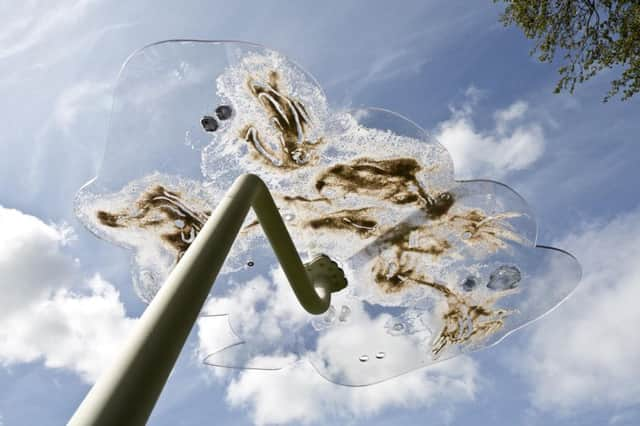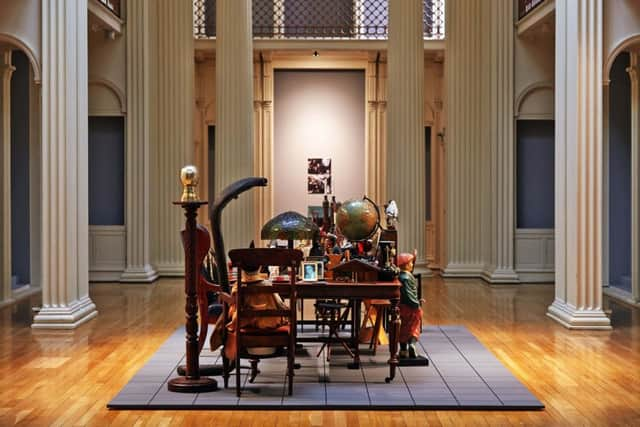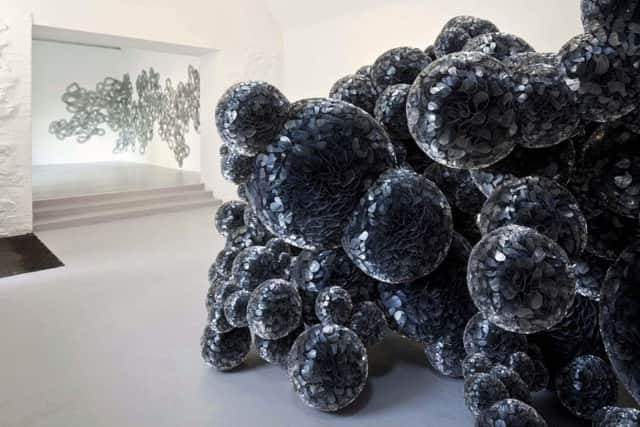Art review: Hanne Darboven | Samara Scott | Lauren Gault | Tara Donovan


Hanne Darboven: Accepting Anything Among Everything, Talbot Rice Gallery, Edinburgh * * * *
Samara Scott * * *
Lauren Gault * * *


Tara Donovan * * * * Jupiter Artland, Wilkieston, near Edinburgh
Advertisement
Hide AdThere are books, pictures and a little wooden birdhouse containing a dusty flock of stuffed songbirds. There’s a plastic dinosaur, a Tiffany lamp. A stuffed cobra rears, comic and terrifying, to the right. An invitation to an opening by the artist Lawrence Wiener sits next to a framed photograph of a goat.
Artist Hanne Darboven once worked at this table, but as it filled up she simply moved on to a new desk. And when the room was full she moved to another. The bourgeois home in suburban Hamburg that belonged to her coffee-manufacturing family became something else: a studio, a collection, a design for living and thinking, an artwork in itself.
In the ranks of conceptual artists Darboven, who died at the age of 67 in 2009, was amongst the hardcore. First trained as a pianist, she lived in New York for a handful of years in the mid-1960s. There, her friendships with figures like Sol LeWitt and Joseph Kosuth, the emerging stars of minimalism and conceptualism, put her on a path that she stuck to rigorously for the rest of her working life.


Darboven returned home to Hamburg in 1968 and for the subsequent four decades developed a series of grand, near meaningless projects that became deeply meaningful through her dedication to them. Working to a rigorous daily routine (and eventually occupying her late parents’ own rooms) she produced and she accumulated.
As this condensed, tough but very rewarding mini-survey show demonstrates, her subject was no less than the century itself. Darboven’s central project consisted of daily drawings, which were mathematical transcriptions of every date of the twentieth century, transcribed using a complicated, personal system of calculation, she described as “construction”. These works were less mathematics than a kind of literature, and less high literature than a kind of daily diary.
In Edinburgh, the 754 framed sheets of hand and type written formulae that rise up to cover every available inch of the high gallery walls are just a proportion of the 2,782 individual works that constitute the project Life/Living (1997-1998). The work is austere and daunting. Yet the task: how to make sense of the world, how to pass time and how to acknowledge its very passing, is deeply human.
Advertisement
Hide AdIt is hard to think of Darboven without thinking of her appearance. A trained musician who was familiar with the politics of performance, her cropped hair, ascetic aesthetic, oversized coats and wide limbed outfits embraced a monastic simplicity. Her art was a modern adaptation of monastic routine: art and work intertwined in a rigorous daily schedule, the secular equivalent of ora et labora, the monk’s life of work and prayer.
Where this marvellous show really works is in its emphasis on Darboven’s artwork as a lived life rather than just an output. In the excellent documentary by William Smerling that accompanies the exhibition we encounter Darboven as a kind of Charlie Chaplin figure, a heroic everyman and a surprisingly comic persona who embraced the rebellious German tradition of carnival. She loved her friends and her collaborators, her pet goats and her absurd and growing collection of stuff.
Advertisement
Hide AdDarboven was keenly aware of both the horror and the absurdity of modern life. You can think of her work in lots of ways. As a means of making a different kind of cultural music in the wake of the excess of Wagner, as kind of penance for the failings of grandiose German arts. She made work that resisted interpretation, because she wanted to resist misinterpretation and the misuse to which culture had been put. But if her work was exceptionally modest in tone it was widely excessive in scale. Seeing the detritus on the desk you grasp that this was strategy as much as psychology.
Jupiter Artland, Robert and Nicky Wilson’s sculpture park outside Edinburgh, combines the pastoral qualities of a rural family home and garden with the glamour of a fairytale castle, replete with a permanent collection of sculpture from big name artists that evokes ghosts and deaths, a jewelled grotto and a meteor shower.
For the Edinburgh Art Festival, Jupiter’s programme places an emphasis on the mystical transformation of materials. In the attic room of the steading Samara Scott appears to have painted a mural, until it emerges that the whole room, including walls, ceiling and floor, are clad in industrial strength contract carpet. It has been cut and crafted and painted with dense imagery that includes scenes from everyday life alongside visual quotes from art historical greats, like a rumpus room of the mind or, as gothic literature would have it, a mad woman in the attic.
On a marginal space at the boundary of the park Lauren Gault’s project Lipstick – NASA is another example of the Glasgow artist’s increasingly compelling work with sculptural forms. The arresting sight of her water and silicon filled plastic mattresses stranded on the grass raise all kinds of questions about form and substance. Gault has said that she often has in mind the image of a beached whale or spermaceti, the whale wax that was once made into candles and cosmetics.
In the Steading Gallery the American artist Tara Donovan has pulled off a trick or two with her charming wall drawing made from slinky toys and a sculpture constructed from cones of Mylar to look like a giant blow-up of tiny molecules. But it is in the ballroom of Bonnington House that she pulls off real magic. Some 600,000 ordinary plastic cups create a beautiful undulating scene of snowdrifts that makes you feel like a giant let loose in winter landscape.
Hanne Darboven until 3 October; Jupiter Artland shows until 27 September, edinburghartfestival.com